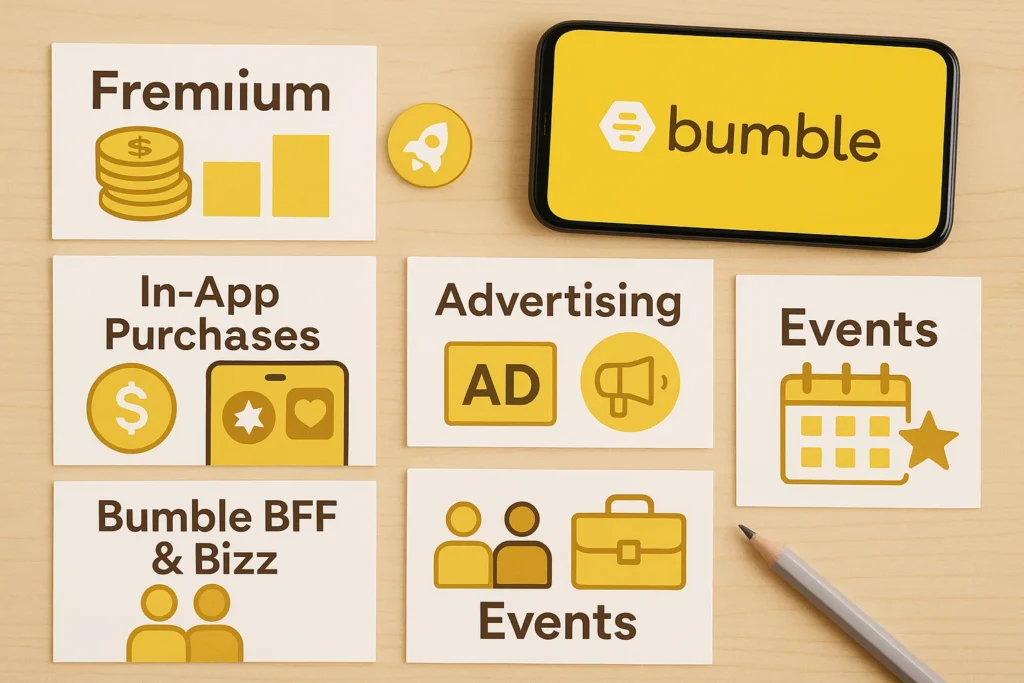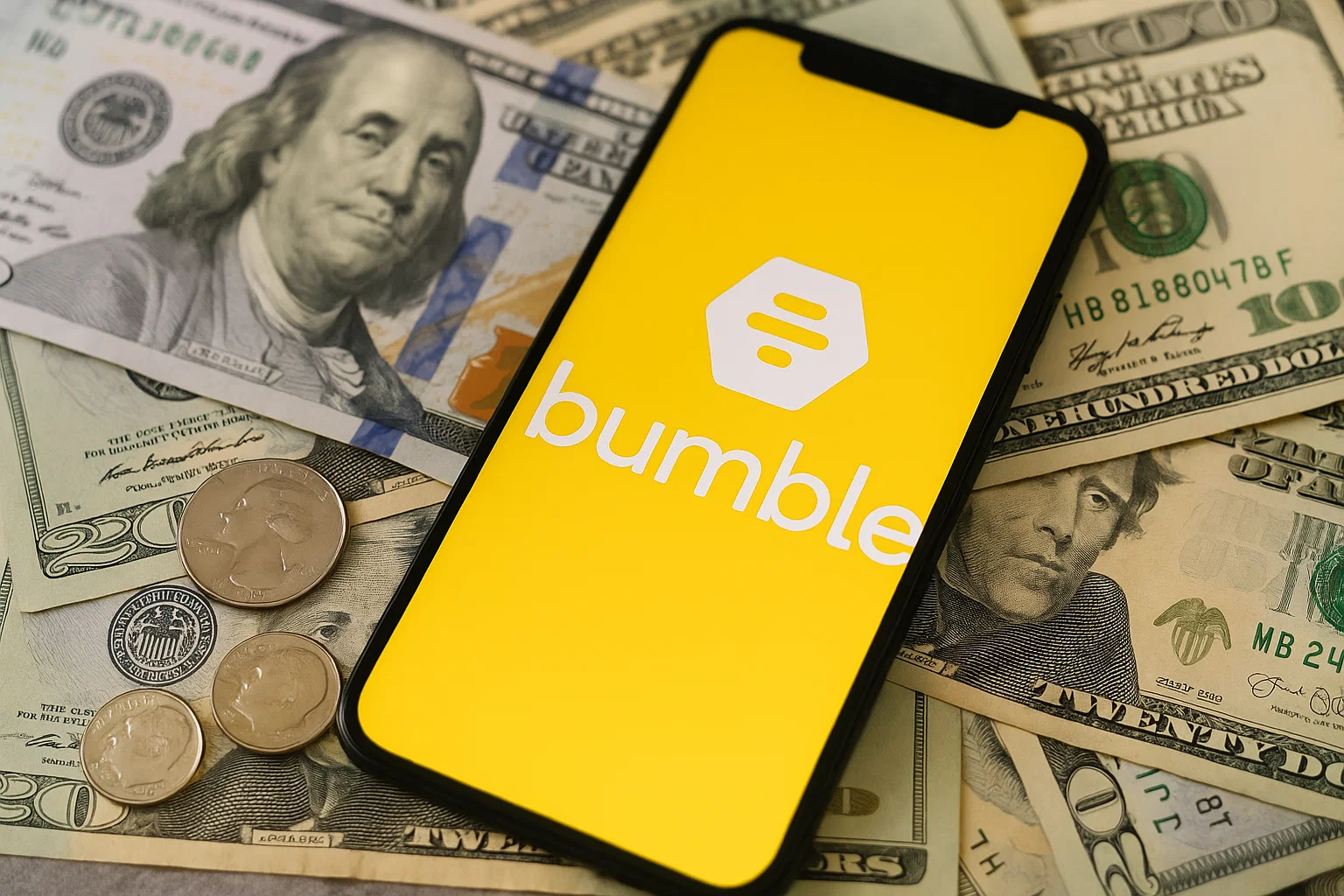Bumble has reshaped the online dating landscape with a bold twist — women make the first move. Launched in 2014 by Whitney Wolfe Herd, Bumble rapidly evolved from a dating app into a broader social connection platform including Bumble BFF (for friendships) and Bumble Bizz (for networking). With over 100 million users across the globe and a successful IPO in 2021, Bumble has firmly positioned itself as a socially conscious tech brand that monetizes relationships, not just profiles.
But behind the empowering UX and swipe mechanics lies a clever revenue engine. Bumble’s monetization strategy combines subscriptions, in-app purchases, advertising, and premium positioning — all while maintaining its core values of safety and inclusivity.
In this blog, we’ll break down the revenue model of Bumble, explore how it works so well in 2025, and explain how startups can replicate this winning approach using Miracuves’ Bumble clone solution.
How Bumble Makes Money
Bumble monetizes its user base through a mix of premium subscriptions, one-time in-app purchases, advertising, and brand partnerships. Here are the major revenue streams that power Bumble’s business:
- Freemium Model with Paid Upgrades – Core app usage is free, but users can pay to unlock premium features like unlimited swipes, advanced filters, and profile boosts.
- Bumble Boost and Bumble Premium – Recurring subscriptions offering features like travel mode, rematch, and incognito browsing.
- In-App Purchases – Users buy virtual currency (“Bumble Coins”) to use on Spotlight, SuperSwipes, or profile promotions.
- Advertising and Sponsored Content – Bumble integrates native ads and brand partnerships that align with its values and user experience.
- Bumble BFF and Bumble Bizz Expansion – These verticals attract new user groups and monetization options beyond dating.
- Events and Brand Collaborations – Offline meetups, co-branded campaigns, and curated experiences offer additional revenue opportunities.

These diversified income sources allow Bumble to generate consistent revenue while staying true to its brand — empowering users to build meaningful connections in all areas of life.
Ready to launch your own dating platform? Explore our Bumble clone script with advanced features and get a fully customizable solution tailored to your business—request a free demo and pricing guide today!
Detailed Breakdown of Revenue Channels
Freemium Model with Paid Upgrades
Bumble operates on a freemium model — anyone can sign up, create a profile, and start swiping for free. However, certain actions are limited unless users upgrade. These limitations create subtle nudges that encourage users to pay for better visibility and features.
- Who Pays? Regular users who want more matches or control.
- Why It Scales? Low barrier to entry means high volume; upgrades convert a meaningful percentage of users into paying customers.
Bumble Boost and Bumble Premium Subscriptions
Bumble offers two key subscription tiers:
- Bumble Boost includes features like seeing who liked you, extending matches, and rematching expired connections.
- Bumble Premium adds travel mode, incognito browsing, and advanced filters.
These are offered on a weekly, monthly, or lifetime basis — giving users flexible options to engage and spend.
- Who Pays? Power users and serious daters.
- Why It Scales? Subscriptions offer predictable, recurring revenue and increase user retention.
In-App Purchases with Bumble Coins
Users can buy “Bumble Coins” to use for one-time perks like:
- Spotlight – Boosts profile visibility for 30 minutes.
- SuperSwipe – Lets someone know you’re especially interested.
- Profile Boosts – Temporarily elevate your profile ranking.
Coins are bought in bundles, encouraging microtransactions.
- Who Pays? Occasional users or those hesitant to commit to subscriptions.
- Why It Scales? Microtransactions appeal to impulse buyers and deliver high-margin revenue.
Advertising and Sponsored Content
Bumble allows select advertisers to run native ads that blend into the app experience — such as sponsored cards, events, and product drops. These are curated to feel less intrusive and more aligned with Bumble’s social-first brand.
- Who Pays? Lifestyle, fashion, wellness, and entertainment brands.
- Why It Scales? Large, engaged user base means high ROI for advertisers.
Bumble BFF and Bumble Bizz
These spin-off verticals open up monetization beyond dating. While still in growth mode, they attract unique partnerships and user segments such as solo travelers, networking communities, and social discovery seekers.
- Who Pays? Users and brands targeting non-romantic connections.
- Why It Scales? Diversifies Bumble’s revenue and extends user lifecycle.
Events and Brand Collaborations
Bumble partners with brands to host exclusive events, city meetups, or themed experiences. These collaborations often involve sponsorship fees, co-branded content, and lead generation — creating experiential revenue streams.
- Who Pays? Sponsoring brands and local business partners.
- Why It Scales? Enhances brand loyalty while monetizing community engagement.
Explore the Bumble marketing strategy that turned swipes into global growth. Learn the tactics your startup can adapt to scale faster in competitive markets.
Why This Revenue Model Works in 2025
Bumble’s monetization strategy remains strong in 2025 because it aligns with evolving user behavior, tech trends, and cultural values. Here’s why this model still works — and why it’s more scalable than ever:
Users Expect Freemium with Premium Options
In 2025, freemium is the norm. Users expect to use an app for free but are increasingly willing to pay for control, visibility, and better matches — especially in dating. Bumble’s tiered subscription model fits perfectly into this expectation and drives reliable recurring revenue.
Gen Z and Millennials Drive Microtransactions
This demographic loves personalization and instant gratification. In-app purchases like SuperSwipes or Spotlight tap into impulse buying behavior while keeping engagement high — all without needing to convert users to long-term subscriptions.
Ethical Branding Drives Ad Revenue
In an era of data privacy concerns and ad fatigue, Bumble’s commitment to inclusivity and safety makes it an attractive platform for brand advertisers. Sponsored content on Bumble often performs better because it feels native and community-oriented.
Diversification Through BFF & Bizz
Bumble’s expansion beyond dating future-proofs its growth. In 2025, social discovery and professional networking are booming sectors. These verticals give Bumble more touchpoints to monetize and keep users engaged even if they’re not actively dating.
AI-Driven Personalization and Matching
Bumble leverages AI for smarter match suggestions, behavior tracking, and content personalization. This not only improves the user experience but also helps upsell the right features at the right time — increasing the likelihood of conversion.
Learn how to build an app like Bumble with our full-stack developer’s guide. Explore the right tech stack, features, and steps to launch your own dating platform.
Can Startups Replicate Bumble’s Revenue Model?
Yes — but not without the right strategy and technology.
Bumble’s success comes from more than just swiping mechanics. Its revenue model is backed by real-time matchmaking algorithms, scalable in-app purchase infrastructure, a smooth UI/UX, and tight data privacy protocols. Rebuilding all of that from scratch takes time, capital, and expertise — which most early-stage startups don’t have.
That’s why many founders are turning to ready-made clone solutions.
With Miracuves’ Bumble Clone, you can replicate the proven monetization model without spending years in development. Our clone app is built to empower your growth journey from Day One.
Here’s what you get:
- In-app purchase system with coins, boosts, and premium unlocks
- Subscription module for freemium upgrades (Boost, Premium tiers)
- Matching algorithms and gender-first interaction flows
- BFF and Bizz-style vertical modules for wider reach
- Admin dashboard to manage ads, pricing, and feature limits
- Multi-language, GDPR-compliant infrastructure
Monetization-ready from launch, our Bumble clone offers the tech foundation you need — with full customization to make the brand your own. You focus on branding, marketing, and community — we’ll handle the platform.
The Bumble Clone by Miracuves is priced at $2,499, offering full customization and white-label flexibility for modern matchmaking.
Empower users with smart, secure, and engaging connection features.
Go live in just 3–6 days with 60 days of tech support.
Explore the top Bumble app features every startup should know to build a competitive dating platform. See why startups choose our Bumble clone over custom builds and check the Bumble app development cost in 2025 before you launch.
Conclusion
Bumble has built one of the most balanced and scalable monetization strategies in the social app space — combining freemium subscriptions, in-app purchases, and brand partnerships, all while maintaining its user-first identity. In 2025, its model continues to thrive thanks to consumer trust, personalization, and the ability to monetize across dating, friendship, and professional networking.
For startups and digital agencies looking to enter the matchmaking or social discovery space, there’s no need to start from scratch. With Miracuves’ Bumble Clone, you get access to a revenue-ready, scalable solution that mirrors Bumble’s proven business model.
FAQs
How does Bumble generate revenue?
Bumble makes money through premium subscriptions (Bumble Boost and Premium), in-app purchases like SuperSwipes and Spotlights, advertising partnerships, and expansion into BFF and Bizz verticals.
Is Bumble profitable in 2025?
While profitability fluctuates due to market expansions and acquisitions, Bumble continues to grow its user base and revenue through high-margin features, solid subscription conversion rates, and diversified offerings.
What are the main income sources for Bumble?
The primary income streams include paid subscriptions, one-time in-app purchases, native advertising, and brand partnerships. Offline events and premium networking features also contribute to its revenue mix.
Can startups use the same revenue model as Bumble?
Yes, but replicating it from scratch is complex. Using a ready-made Bumble clone like the one from Miracuves lets startups adopt Bumble’s monetization model affordably and quickly.
Does Miracuves offer a Bumble clone with monetization features?
Absolutely. Miracuves provides a customizable Bumble clone app with integrated revenue tools including coin-based purchases, subscription tiers, admin controls for ads, and loyalty features.








